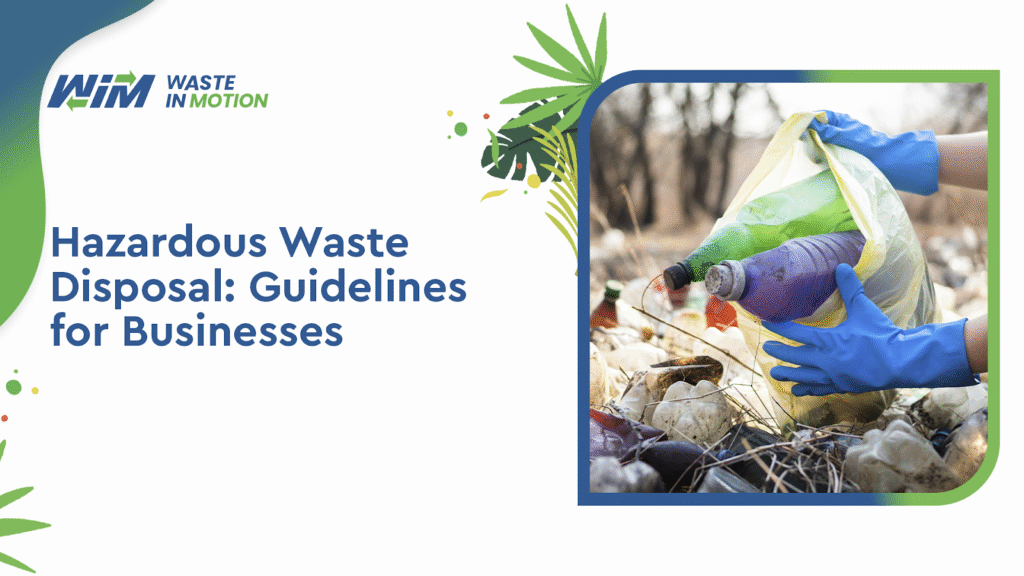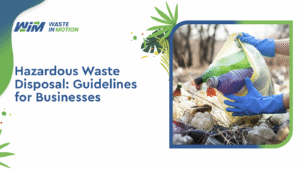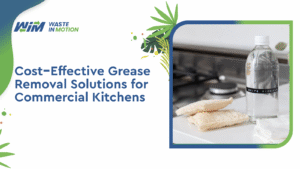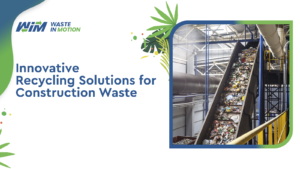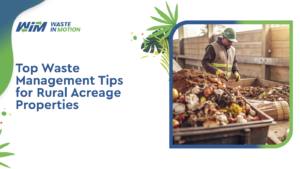From auto repair shops and manufacturing plants to medical facilities and labs, businesses across industries generate waste that goes far beyond everyday trash. When this waste contains substances that are toxic, flammable, corrosive, or reactive, it’s legally classified as hazardous waste, and mishandling it can lead to serious consequences.
Proper hazardous waste disposal guidelines for businesses are crucial for regulatory compliance, protecting public health, avoiding steep fines, and maintaining a positive environmental impact.
Unfortunately, many businesses still underestimate their responsibility when it comes to managing these materials safely!
This blog will walk you through everything you need to know: how to identify hazardous waste, safely store and transport it, remain compliant, and adopt cost-effective strategies; all while reducing your company’s environmental liability.
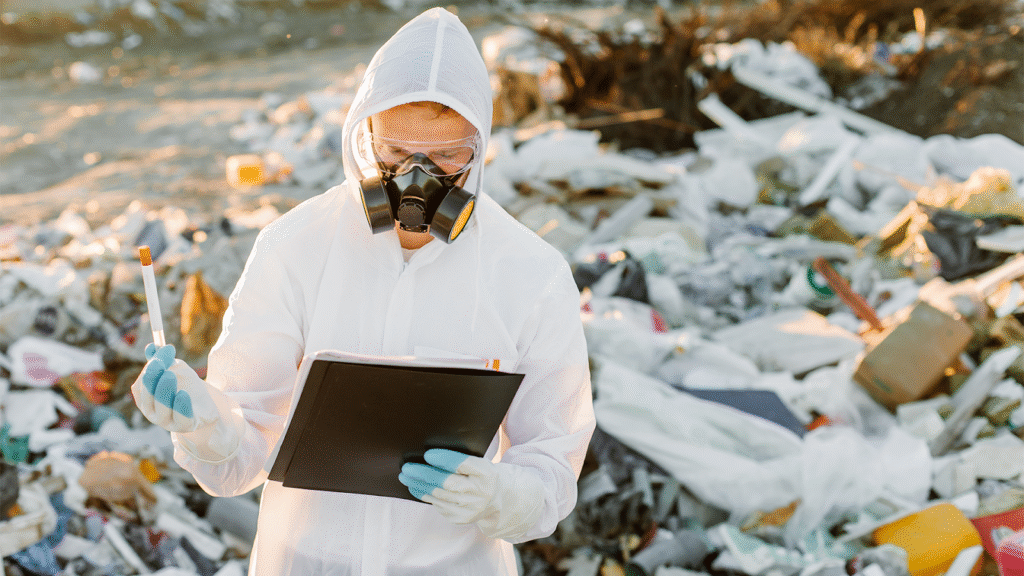
Table of Contents
ToggleWhat is Hazardous Waste?
According to the EPA hazardous waste regulations, hazardous waste is defined as any discarded material that is dangerous or potentially harmful to human health or the environment. The EPA breaks it into four main categories:
- Ignitable: Catches fire easily (e.g., solvents, paint wastes)
- Corrosive: Can corrode metal or skin (e.g., acids and alkalis)
- Reactive: Unstable under normal conditions (e.g., explosives, peroxides)
- Toxic: Harmful or fatal when ingested or absorbed (e.g., lead, mercury)
In business settings, these wastes often fall under additional regulatory categories such as universal waste (e.g., batteries, fluorescent lamps), and require specialized handling and disposal.
Common Hazardous Wastes in Business Settings
- Automotive fluids and parts cleaners
- Industrial chemicals and degreasers
- Medical waste and pharmaceuticals
- Cleaning agents and disinfectants
- Electronics and e-waste
If you’re unsure whether your waste qualifies, a hazardous waste classification process (called “waste characterization“) is mandatory before transport or disposal.
Risks of Improper Hazardous Waste Management
Legal and Regulatory Penalties
Failure to comply with business hazardous waste compliance standards can lead to hefty fines and even criminal charges. In the U.S., the EPA has issued civil penalties exceeding $70,000 per day per violation for major offenders.
Environmental Contamination
Improper disposal, such as dumping into landfills or drains, can cause long-lasting soil and water pollution, harming ecosystems and contaminating public water supplies.
Health and Safety Hazards
Poor storage or handling practices can expose employees to dangerous chemicals, increasing the risk of burns, poisoning, or respiratory damage. In some cases, this can also lead to explosions or fires, triggering workplace shutdowns and liability lawsuits.
Regulatory Framework for Hazardous Waste Disposal
Businesses must comply with regulations at three levels:
- Federal: EPA’s Resource Conservation and Recovery Act (RCRA)
- State: State-specific hazardous waste codes and reporting requirements
- Local: Municipal storage and zoning laws
These regulations determine how waste should be classified, labeled, stored, transported, and tracked via the hazardous waste manifest system.
If your facility generates hazardous waste, you’re likely classified under one of the following:
- Very Small Quantity Generator (VSQG)
- Small Quantity Generator (SQG)
- Large Quantity Generator (LQG)
Each classification has its own thresholds and reporting rules. It’s critical to understand your designation to avoid non-compliance.
You can explore how businesses in rural settings navigate these challenges in this detailed article on waste management for acreage properties.
Identifying and Classifying Hazardous Waste
Waste Characterization Process
Businesses must perform tests or use documentation (like SDSs) to determine if waste is hazardous. This process includes:
- Checking waste against EPA’s hazardous waste listings
- Determining if it has characteristics like ignitability or toxicity
- Assigning a proper waste code
Labeling and Documentation Requirements
Proper labels must include:
- “Hazardous Waste” signage
- Accumulation start dates
- Generator information
- Hazard class (e.g., corrosive, flammable)
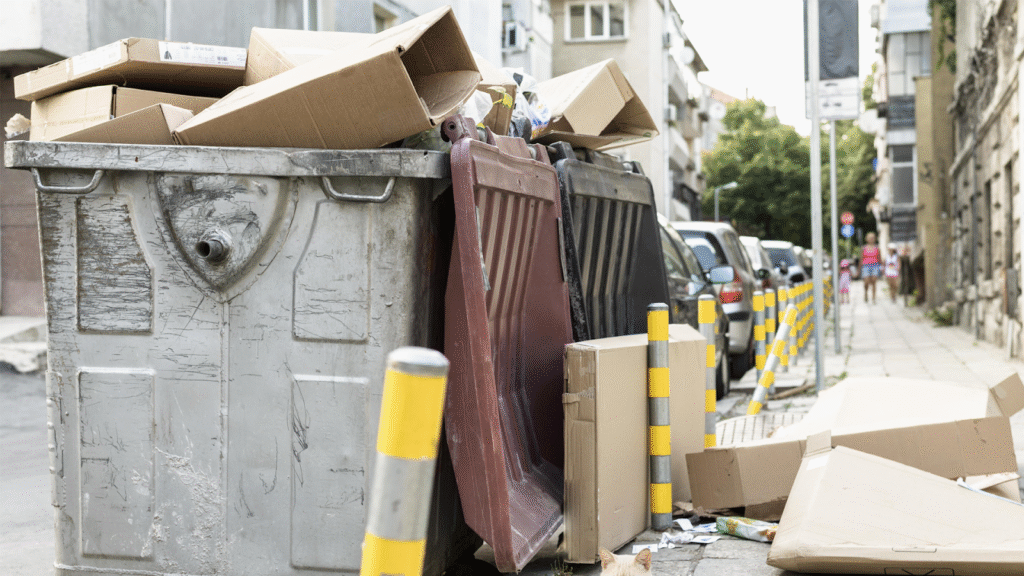
Safe Storage and Handling of Hazardous Waste
Container Requirements
Containers must be:
- Compatible with the type of waste stored
- Free of leaks or damage
- Properly sealed and labeled
- Stored away from ignition sources or public areas
Spill Prevention and Emergency Preparedness
Facilities must have a hazardous material handling plan in place, including:
- Secondary containment
- Spill kits and PPE
- Emergency eye wash stations
- On-site emergency response protocols
Even if you’re not a major generator, you must prepare for worst-case scenarios. Regular staff training and mock drills are recommended.
Hazardous Waste Transportation and Disposal Options
Choosing Licensed Transporters and Disposal Facilities
Always use licensed hazardous waste transporters registered with your local environmental authority and compliant with DOT standards. They ensure proper chain-of-custody procedures and safe delivery to certified disposal facilities.
Many companies work under waste contracts that include routine pickups, documentation, and disposal scheduling to streamline the process.
Manifest System and Recordkeeping
A hazardous waste manifest must accompany all transported waste and include:
- Generator and transporter details
- Waste description and volume
- Destination facility information
Copies must be kept on file for at least 3 years, and discrepancies must be reported immediately.
Cost-Effective and Environmentally Responsible Disposal Strategies
Reducing waste at the source is the most affordable and sustainable strategy. Some options include:
- Substituting non-hazardous materials when possible
- Installing closed-loop systems that reuse solvents
- Using hazardous waste recycling programs to recover materials like metals, oil, or chemicals
Reputable providers handle everything from classification to disposal while keeping you compliant. Look for those that:
- Offer documentation and reporting tools
- Provide consulting or training for your staff
- Use advanced treatment or neutralization technologies
Learn how smart tools support safer operations in our technology-focused waste management blog.
Ensuring Ongoing Compliance and Staff Training
Regular Audits and Updates
Conduct routine internal audits and consult with environmental experts to:
- Identify new waste streams
- Update safety data sheets
- Revise protocols as regulations evolve
Employee Training Programs
Your compliance is only as strong as your staff’s knowledge. Training should cover:
- Waste identification and labeling
- Spill response
- Safe handling procedures
- Use of personal protective equipment
Refreshers should be held annually and whenever new employees are onboarded or regulations change.
Check out our guide on streamlined waste disposal for property managers to learn how these practices scale across industries.
Conclusion
Handling hazardous waste responsibly isn’t just about avoiding fines—it’s about protecting your people, your community, and your brand. Following proper hazardous waste disposal guidelines for businesses ensures you stay compliant, prevent environmental harm, and operate more sustainably.
Stay proactive, stay informed, and remember: that effective hazardous waste management starts long before the waste ever leaves your site.
Frequently Asked Questions
What types of business waste are considered hazardous?
Hazardous business waste includes ignitable, toxic, corrosive, or reactive. Common examples are solvents, chemical cleaners, batteries, aerosols, oil-based paints, and medical waste. If your waste could pose harm to people or the environment, it likely qualifies as hazardous under EPA rules.
How can businesses minimize hazardous waste disposal costs?
Start with waste minimization strategies like using less-toxic alternatives, recycling spent materials, and training staff on proper disposal. Partnering with a certified provider can also cut costs by bundling transport, treatment, and documentation services.
What are the penalties for improper hazardous waste disposal?
Penalties vary by jurisdiction, but federal fines can exceed $70,000 per violation per day. Businesses may also face lawsuits, cleanup costs, or even criminal charges if their actions result in environmental damage or harm.
How often should hazardous waste be removed from a business site?
Removal frequency depends on how much waste you generate. For example, small-quantity generators must ship waste at least every 180 days, while large-quantity generators are required to do so within 90 days.
Can hazardous waste be recycled or treated for reuse?
Yes, many hazardous wastes can be safely treated or recycled. Used solvents, oils, metals, and even some acids can be recovered and reused in industrial processes. This cuts disposal costs and supports sustainable business practices.


